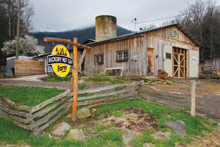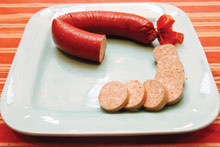McCormick Field’s peanuts and Cracker Jack will likely take a back seat to hot dogs this baseball season—which will be made from locally pastured pork and organic ingredients.

The Asheville Tourists, late last month, reached an agreement with Fairview’s Hickory Nut Gap Farm to offer their hot dogs at the park’s concession stands. While the standard $3 all-beef dog will stay on the menu, hungry spectators can now shell out an extra dollar to support their home team of farmers.
“Asheville’s a pretty food savvy town, so it makes sense,” says Brian Candler, who oversees food and beverage operations for the Tourists. “It’s probably not the most cost-effective thing we could be doing, but, in terms of enhancing the customer experience, it’s great.”
Americans have become increasingly concerned about their food’s origins, but Western North Carolinian eaters are apparently among the few baseball fans who don’t check their gastropolitics at the turnstile. Let followers of the Savannah Sand Gnats busy themselves with dizzy bat races and bobblehead giveaways: The Tourists’ faithful care deeply about who made their hot dogs. How many other ballparks can boast of selling meat products from a family farm just 16.1 miles from the pitcher’s mound?
“Probably very few, to be honest,” Candler says in a vaguely wondrous tone that suggests he might be readying for a ribbing from colleagues at other minor-league parks, where Buffalo wing pretzels and bacon cheeseburgers are sandwiched between doughnuts and Frito-pie burgers count as serious culinary upgrades.

But Tourists fans’ culinary conscientiousness shouldn’t be mistaken for effeteness: Far from being a bunch of white-wine sippers, patrons of the park, which legendarily debuted the “Thirsty Thursday” concept back in 1980, are thoroughly smitten with beer. Game-goers this year will be able to wash down their Hickory Nut Gap hot dogs with local beer from the park’s brand new “Beers of Asheville” stand, which will debut at the team’s home opener on Monday. The stand will feature brews from The Wedge, Asheville Brewing Company, Highland Brewing, Green Man Ales and French Broad Brewing—already a popular player at McCormick Field.
Still, Candler confesses he hadn’t considered offering locally grown food to complement the local beverage selection until Jamie Ager of Hickory Nut Gap called him.
“This is one part of a bigger value-added picture we’re trying to create,” explains Ager, who recently added bratwurst, kielbasa and ring bologna to his farm’s product list. “Honestly, what we have to do is sell a whole cow, and only about 15 percent of a cow is steaks. This gives us a way to move the lower grade cuts.”
In today’s market, where mainstream middle-America products like Quaker oatmeal and Kraft boxed mac and cheese now proudly bear the “organic” label, consumers’ interest in processed meats with a pedigree isn’t especially surprising. But Ager’s embrace of such convenience products, which are widely—if unfairly—viewed as the antithesis of small-scale sustainable farming, is a notable development that bodes well for the future of local food.
These are our bologna days: Appalachian foodways scholar reflects on resurgence of frugal meat product
by H.R.R.
Organic bologna may be fairly newfangled, but the lunch meat has a proud local history. The classic bologna sandwich —bologna and mayo on white (hold the lettuce)—was a staple of Appalachian lunch counters and cafeterias. Scholars of mountain cookery so cherish bologna that when I e-mailed Fred Sauceman—author of three volumes of The Place Setting: Timeless Tastes of the Mountain South, from Bright Hope to Frog Level (Mercer University Press, 2006-2009)—for a few thoughts on the topic, he interrupted his enjoyment of the SEC championship tournament in Tampa to pen the following manifesto:
“Marilyn Farthing, fountain manager at Boone Drug in Boone, North Carolina, gave me some heartening news recently: Maybe some balance is returning to the world and the fried bologna sandwich is experiencing a resurgence. Even in granola-rich Boone, Marilyn says, people are beginning to ask for fried bologna sandwiches again.
“Bologna sandwiches in convenience markets, drugstores, and luncheonettes often get lettuced and tomatoed these days, but I know of at least half a dozen places within driving distance of my Northeast Tennessee home where I can get one. The Quik Stop in Weber City, Virginia, plates them up, as do The City Market in Elizabethton, Tennessee, and Cappy’s Apex in Johnson City.
“Yet the bologna sandwich hasn’t quite shaken the shame and guilt. At the Sycamore Restaurant in Elizabethton, Tennessee, owner Gary Hicks serves a Bologna Burger. He says he didn’t want to call it a bologna sandwich because of the light bread implication. “People get us aside and ask us what is a Bologna Burger,” Gary tells me. “They don’t want to say Bologna Burger out loud.”
Sycamore’s Bologna Burger is a hamburger impersonator. Rather than the traditional thin slices of bologna, it consists of a 3/8-inch hunk, lightly grilled (the word “fried” isn’t used) and surrounded by the dressings and condiments that typically adorn a hamburger.
“Fried bologna in its purest form, without bread, may be disappearing as a breakfast meat. I know of only one place where it’s served that way: Clarence’s Drive-In, in Unicoi County, Tennessee, one of the few locally owned breakfast stops in the region, where biscuits and gravy are made from scratch every day.
“Fried bologna was my first childhood cooking endeavor. I never joined the “scored” school, opting, instead, to slice the rounds of bologna completely in half and brown them lightly in butter. Lettuce and tomato would have only interfered with the symbiosis of cheap light bread and greasy luncheon meat. My rule on bologna condiments has always been: mayonnaise on cold or room-temperature sandwiches, mustard on fried.
“Food City, a regional chain based in Abingdon, Virginia, has begun re-introducing once-extinct products like Kay’s Ice Cream and Terry’s Potato Chips. The company has added Lay’s luncheon meats to the nostalgic line. The meat blend and spicing combination of the bologna match my memory of what the 1960s-era product was like.
“We’ll probably never return to the days when fried bologna was a weekly feature on school lunch menus in Appalachia, but perhaps today’s dollars-and-cents deprivation is creating new respect for this inexpensive descendent of the sausages of Europe.”
“If we can build up demand with this type of product, it’s a big part of rebuilding the local food economy,” Ager says.
There is a certain romance in buying a just-butchered side of cow, a quintessential coming-of-age experience for devoted foodies. No memoir of an epicurean’s irreversible descent into edible obsession is complete without at least one breathless tale of buying too much of one animal—a whole hog, the hind of a moose, the head of a sheep. Such Herculean purchases make for good cocktail-party chatter, but tend to brutalize a household’s budget—and its available freezer space.
“What do you do with a pork shoulder roast?,” Ager asks. “People don’t know what to do with a pork shoulder roast, but they know what to do with a hot dog.”
Ager isn’t about to get all high and mighty about his processed meats: Their appeal lies in their simplicity. “It’s bologna, man,” he laughs.
Since the region is still without its own meat processing plant, Hickory Nut Gap Farms ships its beef and pork to Troy, Pennsylvania, where a certified-organic butcher shop handles mixing the raw product with salt, pepper, coriander, nutmeg, sugar, mustard, garlic and onion powder to create the bologna bearing Hickory Nut Gap’s name.
“It’s the not the junk we all grew up on,” says Mike DeBach, whose father opened Leona Meat Plant in 1963. “In the meat business, there’s always someone putting together odds and ends and calling it bologna. Some people’s idea of bologna is not what we make.”
Leona Meats makes a variety of bologna styles, but Ager eventually settled on a ring bologna, which folks familiar with German sausage will recognize as a closer cousin to landjaegers than the sliced bologna, which shows up in sandwiches across the mountain South (see sidebar). Ager experimented with the traditional Appalachian bologna, but deemed the product too sugary. Ager describes the ring bologna as slightly more “gourmet.”
“You can just take it home, slice it up, and put it with some crackers and cheese,” Ager says.
DeBach, who confirms a growing number of small farms are ordering processed meat products, likens the ring bologna to summer sausage.
“It’s got a bit of a bite,” he says. “We add the seasonings and put it into the smokehouse for three hours. We don’t put any liquid smoke in the product.”
Ager is just happy to have something to do with his pork-belly trimmings, ground beef and boned-out pork sirloins. And he’s hoping the bratwurst, bologna and hot dogs sent back to the South from Leona will help create a new group of local meat eaters.
“The modern-day meat industry is so much about convenience products,” Ager says. “It’s not just cooking hunks of meat. These products will help move us forward.”



AWESOME!!!
Local hot dogs and local beer?
I will more than likely attend my first Tourists game this year because of this new decision.
great site. we have a beef operation in virginia. you have good ideas. thanks. jim myers.